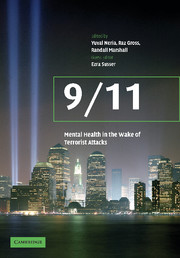Book contents
- Frontmatter
- Contents
- Acknowledgments
- Editors brief bio
- List of contributors
- Foreword
- Part I Introduction
- Part II The psychological aftermath of 9/11
- Part III Reducing the burden: community response and community recovery
- Part IV Outreach and intervention in the wake of terrorist attacks
- Part IV A New York area
- 16 PTSD in urban primary care patients following 9/11
- 17 Project Liberty: responding to mental health needs after the World Trade Center terrorist attacks
- 18 Mental health services support in response to September 11: the central role of the Mental Health Association of New York City
- 19 The New York Consortium for Effective Trauma Treatment
- 20 Evaluation and treatment of firefighters and utility workers following the World Trade Center attacks
- 21 The World Trade Center Worker/Volunteer Mental Health Screening Program
- 22 Child and adolescent trauma treatments and services after September 11: implementing evidence-based practices into complex child services systems
- 23 Relationally and developmentally focused interventions with young children and their caregivers in the wake of terrorism and other violent experiences
- Part IV B Washington, DC
- Part IV C Prolonged-exposure treatment as a core resource for clinicians in the community: dissemination of trauma knowledge post-disaster
- Part V Disasters and mental health: perspectives on response and preparedness
- Index
21 - The World Trade Center Worker/Volunteer Mental Health Screening Program
from Part IV A - New York area
Published online by Cambridge University Press: 27 October 2009
- Frontmatter
- Contents
- Acknowledgments
- Editors brief bio
- List of contributors
- Foreword
- Part I Introduction
- Part II The psychological aftermath of 9/11
- Part III Reducing the burden: community response and community recovery
- Part IV Outreach and intervention in the wake of terrorist attacks
- Part IV A New York area
- 16 PTSD in urban primary care patients following 9/11
- 17 Project Liberty: responding to mental health needs after the World Trade Center terrorist attacks
- 18 Mental health services support in response to September 11: the central role of the Mental Health Association of New York City
- 19 The New York Consortium for Effective Trauma Treatment
- 20 Evaluation and treatment of firefighters and utility workers following the World Trade Center attacks
- 21 The World Trade Center Worker/Volunteer Mental Health Screening Program
- 22 Child and adolescent trauma treatments and services after September 11: implementing evidence-based practices into complex child services systems
- 23 Relationally and developmentally focused interventions with young children and their caregivers in the wake of terrorism and other violent experiences
- Part IV B Washington, DC
- Part IV C Prolonged-exposure treatment as a core resource for clinicians in the community: dissemination of trauma knowledge post-disaster
- Part V Disasters and mental health: perspectives on response and preparedness
- Index
Summary
The traumatic exposure
The dramatic effect of the pictures notwithstanding, the physical and mental effects of being at “Ground Zero” were described by many “Ground Zero workers” as only able to be understood through direct experience of it. The site occupied 16 acres in lower Manhattan, with buildings grouped around a 5-acre central plaza. The site is bounded by Vesey Street on the north, Church Street on the east, Liberty Street on the south, and West Street on the west, about three blocks north of the New York Stock Exchange. The Twin Towers were 110 stories, 1353 feet (412 meters) tall. In total, there were about 10,000,000 square feet of rentable space. About 50,000 people occupied the buildings. There were 43,200 square feet (4020 square meters) – about an acre of rentable space – on each floor. The seven buildings were made up of 95% air by volume, and contained 15 million square feet of space. Commercially, the seven-story mall beneath the World Trade Center (WTC) was America's third most heavily trafficked mall (Tomasky, 2003). In the aftermath of 9/11, the site continues to be an object of much interest, discussion and meaning for droves of visitors.
Whatever else “Ground Zero” may have been, it was also the workplace for a large number of workers and volunteers. In addition to the firemen and policemen whose volunteer, rescue, and recovery efforts have been chronicled in the media, “Ground Zero” also provided employment for at least 50 other professions, as well as a host of volunteers.
- Type
- Chapter
- Information
- 9/11: Mental Health in the Wake of Terrorist Attacks , pp. 355 - 377Publisher: Cambridge University PressPrint publication year: 2006
- 1
- Cited by



